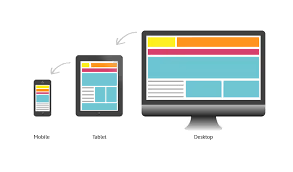In the highly competitive digital landscape, businesses need to implement strategies that drive traffic, improve user experience, and ultimately increase conversions. One of the most effective ways to achieve these goals is through responsive web portal design. As users increasingly access websites from a variety of devices—ranging from desktops and laptops to smartphones and tablets—ensuring that your web portal provides a seamless experience across all devices is critical.
Responsive design has emerged as a key factor in not only enhancing user experience but also boosting search engine optimization (SEO) and conversion rates. Let’s explore how responsive web portal design can significantly impact both these areas and help businesses achieve long-term success.
1. Google’s Mobile-First Indexing and SEO
One of the most critical aspects of SEO is visibility on search engines like Google. In recent years, Google has shifted to a mobile-first indexing approach, meaning that the search engine primarily uses the mobile version of a website for indexing and ranking purposes. If your web portal is not optimized for mobile devices, it could harm your rankings, making it more difficult for potential customers to find you.
How Responsive Design Boosts SEO:
- Optimized for Mobile: A responsive web portal ensures that your site is mobile-friendly, which is a key ranking factor for Google. By adapting to different screen sizes and devices, you can improve your chances of ranking higher in search engine results.
- Single URL Structure: With responsive design, you maintain a single URL structure for both desktop and mobile versions of your site. This not only simplifies SEO management but also ensures that all backlinks point to a single URL, which helps consolidate your site’s authority and improve search rankings.
- Faster Load Times: Page speed is another critical SEO factor. Responsive design optimizes loading times across all devices, particularly on mobile, where connection speeds may be slower. A faster site improves both user experience and SEO rankings, as Google favors fast-loading websites.
2. Reducing Bounce Rates and Increasing Time on Site
Bounce rate refers to the percentage of visitors who leave a site after viewing only one page. High bounce rates can negatively impact SEO because search engines may interpret this as a signal that users are not finding the content valuable. A responsive web portal can help reduce bounce rates by providing a user-friendly, visually appealing experience across all devices.
How Responsive Design Reduces Bounce Rates:
- Improved User Experience: A responsive design ensures that users can easily navigate your web portal, no matter the device they’re using. Mobile visitors won’t struggle with distorted layouts or small text, reducing frustration and increasing the likelihood that they’ll explore more pages.
- Lower Exit Rates: By providing an optimized experience, users are less likely to leave after visiting just one page. This signals to search engines that your content is relevant and valuable, contributing to improved SEO rankings.
How Responsive Design Increases Time on Site:
- Engaging Visuals: Responsive design makes sure that your site’s design, images, and content adapt to the screen size. Users are more likely to stay longer on a website that looks clean, modern, and is easy to read or interact with on their specific device.
- Streamlined Navigation: Responsive design also ensures that your web portal’s navigation is intuitive and easy to use across different devices. Simplified menus and quick access to important information make users more likely to stay longer and explore your site.
3. Enhancing Mobile User Experience for Higher Conversions
Mobile traffic now makes up more than half of all global web traffic, which means that your web portal’s mobile experience is crucial to your business’s success. A responsive design enhances the mobile experience by ensuring that the site looks good and functions smoothly on small screens. This not only improves user satisfaction but can significantly impact conversion rates.
How Responsive Design Boosts Conversions on Mobile:
- Optimized Forms and CTAs: Forms, buttons, and calls to action (CTAs) are critical elements for driving conversions, whether it’s signing up for a newsletter, making a purchase, or requesting more information. Responsive design ensures that these elements are sized correctly and easy to interact with on mobile devices, reducing friction in the conversion process.
- Faster Checkouts: For e-commerce sites, a responsive design streamlines the checkout process on mobile devices. Users can easily navigate through forms, payment pages, and product catalogs without encountering issues like zooming in or slow load times, reducing cart abandonment and increasing conversion rates.
- Seamless Experience: Customers often switch between devices during the purchasing journey—starting on a mobile device and finishing on a desktop, for instance. A responsive design ensures that this transition is seamless, providing consistent information, layouts, and navigation, which encourages users to complete the purchase.
4. Improving Local SEO with Responsive Design
Local SEO is crucial for businesses that rely on attracting customers from a specific geographical area. Mobile users often search for local businesses while on the go, making it essential for your web portal to be optimized for local search.
How Responsive Design Supports Local SEO:
- Google My Business Integration: A responsive design makes it easier for your web portal to integrate with Google My Business listings, which are crucial for local search visibility. Mobile-friendly sites that load quickly and display relevant business information, such as operating hours, addresses, and contact details, rank higher in local search results.
- Mobile Search Behavior: Mobile users frequently search for local services or products with phrases like “near me.” A responsive site that is optimized for mobile devices has a better chance of appearing in local search results, driving foot traffic and conversions for businesses with a physical location.
- Click-to-Call Functionality: Responsive design allows for click-to-call buttons, which are essential for local businesses. Mobile users who find your business via local search can instantly call you with a single tap, increasing the chances of conversions and appointments.
5. Lower Maintenance and Higher Cost Efficiency
Managing separate desktop and mobile websites can be costly and time-consuming, both in terms of development and ongoing updates. A responsive design eliminates the need for separate versions, streamlining the process and reducing costs.
How Responsive Design Enhances Efficiency:
- Single Site Management: Responsive design enables businesses to maintain one website that adapts to all devices. This simplifies updates, content management, and SEO efforts, as you only need to make changes in one place. As a result, businesses save time and money while still delivering a top-tier experience across devices.
- Consistent Content Delivery: With responsive design, you ensure that the same content and branding is delivered to all users, no matter what device they are using. This consistency not only improves user experience but also strengthens your SEO efforts, as search engines are more likely to prioritize sites that provide uniform, high-quality content across devices.
6. Keeping Up with Algorithm Changes and Future-Proofing Your SEO
Search engines, particularly Google, are continuously evolving their algorithms to provide users with the most relevant and high-quality results. As mobile usage grows, it’s expected that search algorithms will continue to prioritize websites that deliver a fast, seamless, and responsive mobile experience. By adopting responsive web design, you’re essentially future-proofing your SEO efforts.
How Responsive Design Future-Proofs SEO:
- Adapting to New Devices: As new devices with varying screen sizes and capabilities emerge, a responsive web portal ensures that your site can adapt. This flexibility positions your business to continue ranking well in search results, regardless of changes in user behavior or device trends.
- Staying Ahead of Algorithm Updates: Google regularly updates its algorithms to reward websites that provide the best user experience. With responsive design, you’re ensuring that your web portal aligns with Google’s focus on mobile-first indexing, fast load times, and user-friendly design—all of which contribute to maintaining strong search rankings.
Conclusion: Responsive Design as a Key Growth Driver
Responsive web portal design is no longer optional for businesses looking to thrive in the digital age. It plays a pivotal role in boosting both SEO and conversion rates by improving mobile experiences, reducing bounce rates, increasing time on site, and streamlining the user journey.
By investing in a responsive design, businesses not only enhance their search engine visibility but also deliver a superior user experience that drives higher engagement and conversions. In an increasingly mobile-first world, businesses that prioritize responsive design will be better positioned to succeed, attract more customers, and achieve sustainable growth in the competitive digital marketplace.
To learn more about our vision stay up to date with latest news and trends and how we’re making a difference, We invite you to OC-B by Oort X Media.




